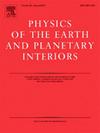Surface wave attenuation beneath the Himalaya-Tibet region constrained by fundamental mode of Rayleigh wave from the Hi-CLIMB dataset
IF 1.9
3区 地球科学
Q2 GEOCHEMISTRY & GEOPHYSICS
引用次数: 0
Abstract
This study investigates Rayleigh wave group velocity and surface wave attenuation coefficients in the Himalaya-Tibet region using seismograms from 16 earthquakes recorded along the Hi-CLIMB network. The observed amplitude variations reveal a decreasing trend with distance, attributed to geometrical spreading, source radiation, wavefield scattering, and intrinsic attenuation. Attenuation coefficients range from 0.00167 km−1 to 0.00039 km−1 across the study area, while Rayleigh wave group velocities vary from 2.5 to 3.2 km/s for periods between 5 and 40 s. A strong frequency dependency in attenuation is observed, with attenuation coefficients peaking at shorter periods, consistent with similar trends reported in other tectonically active regions. Comparisons with global tectonic regions reveal higher attenuation beneath the study area, indicating low Q (41–82) values associated with mechanically weak, partially melted crust. The attenuation model suggests intrinsic attenuation as the dominant mechanism, though scattering effects cannot be ignored due to the region's structural complexity. Understanding these attenuation characteristics helps in interpreting seismic data and developing accurate ground motion prediction models, which are crucial for infrastructure resilience and early warning systems in this seismically active region. This, in turn, enhances seismic monitoring capabilities.

基于Hi-CLIMB数据集的瑞利波基模态约束下的喜马拉雅-西藏地区地表波衰减
利用Hi-CLIMB台网记录的16次地震记录,研究了喜马拉雅-西藏地区的瑞利波群速度和面波衰减系数。由于几何扩散、源辐射、波场散射和本征衰减,观测到的振幅变化随距离的增加呈减小趋势。整个研究区域的衰减系数范围为0.00167 km−1至0.00039 km−1,而瑞利波群速度变化范围为2.5至3.2 km/s,周期为5至40 s。观测到衰减具有很强的频率依赖性,衰减系数在较短的周期内达到峰值,这与在其他构造活跃区域报道的类似趋势一致。与全球构造区相比,研究区下方的衰减更大,表明低Q值(41-82)与机械弱的部分熔融地壳有关。衰减模型表明本征衰减是主要机制,但由于区域结构的复杂性,散射效应也不能忽略。了解这些衰减特征有助于解释地震数据和开发准确的地面运动预测模型,这对地震活跃地区的基础设施恢复能力和早期预警系统至关重要。这反过来又增强了地震监测能力。
本文章由计算机程序翻译,如有差异,请以英文原文为准。
求助全文
约1分钟内获得全文
求助全文
来源期刊

Physics of the Earth and Planetary Interiors
地学天文-地球化学与地球物理
CiteScore
5.00
自引率
4.30%
发文量
78
审稿时长
18.5 weeks
期刊介绍:
Launched in 1968 to fill the need for an international journal in the field of planetary physics, geodesy and geophysics, Physics of the Earth and Planetary Interiors has now grown to become important reading matter for all geophysicists. It is the only journal to be entirely devoted to the physical and chemical processes of planetary interiors.
Original research papers, review articles, short communications and book reviews are all published on a regular basis; and from time to time special issues of the journal are devoted to the publication of the proceedings of symposia and congresses which the editors feel will be of particular interest to the reader.
 求助内容:
求助内容: 应助结果提醒方式:
应助结果提醒方式:


